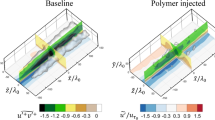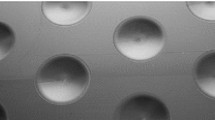Abstract
The structure of turbulence in a drag-reduced flat-plate boundary layer flow has been studied with particle image velocimetry (PIV). Drag reduction was achieved by injection of a concentrated polymer solution through a spanwise slot along the test wall at a location upstream of the PIV measurement station. Planes of velocity were measured parallel to the wall (x–z plane), for a total of 30 planes across the thickness of the boundary layer. For increasing drag reduction, we found a significant modification of the near-wall structure of turbulence with a coarsening of the low-speed velocity streaks and a reduction in the number and strength of near-wall vortical structures.








Similar content being viewed by others
References
Achia BU, Thompson DW (1977) Structure of the turbulent boundary in drag-reducing flow. J Fluid Mech 81:439–464
Adrian RJ, Christensen KT, Liu ZC (2000) Analysis and interpretation of instantaneous turbulent velocity fields. Exp Fluids 29:275–290
Choi H, Moin P, Kim J (1994) Active turbulence control for drag reduction in wall-bounded flows. J Fluid Mech 262:75–110
Djenidi L, Dubief Y, Antonia RA (1997) Advantages of using a power law in a low R θ turbulent boundary layer. Exp Fluids 22:348–350
Donohue GL, Tiederman WG, Reischman MM (1972) Flow visualization of the near-wall region in a drag-reducing channel flow. J Fluid Mech 56:559–575
Gupta MK, Metzner AB, Hartnett JP (1967) Turbulent heat-transfer characteristics of viscoelastic fluids. Int J Heat Mass Transfer 10:1211–1224
Hart DP (2000) PIV error correction. Exp Fluids 29:13–22
Henck RW (1990) An experimental investigation of the fluid mechanics of an unsteady, three-dimensional separation. PhD Thesis, Stanford University
Jiménez J, Pinelli A (1999) The autonomous cycle of near-wall turbulence. J Fluid Mech 389:335–359
Keane RD, Adrian RJ, Zhang Y (1995) Super-resolution particle imaging velocimetry. Meas Sci Technol 6:754–768
Kim J, Moin R, Moser R (1987) Turbulence statistics in fully developed channel flow at low Reynolds number. J Fluid Mech 177:133–166
Kline SJ, Reynolds WC, Schraub FA, Runstadler PW (1967) The structure of turbulent boundary layers. J Fluid Mech 30:741–773
Lumley JL (1969) Drag reduction by additives. Ann Rev Fluid Mech 1:367–384
Naqwi AA, Reynolds WC (1991) Measurement of turbulent wall velocity-gradients using cylindrical waves of laser-light. Exp Fluids 10:257–266
Oldaker DK, Tiederman WG (1977) Structure of the turbulent boundary layer in drag reducing pipe flow. Phys Fluids 20:S133-S144
Pal S, Deutsch S, Merkle CL (1989) A comparison of shear stress fluctuation statistics between microbubble modified and polymer modified turbulent boundary layers. Phys Fluids A 1:1360–1362
Petrie HL, Fontaine AA (1996) Comparison of turbulent boundary layer modification with slot-injected and homogeneous drag-reducing polymer solutions. In: ASME Fluid Engineering Division Summer Meeting FED 237:205–210
Spalart PR (1988) Direct simulation of a turbulent boundary layer up to R θ =1,410. J Fluid Mech 187:61–98
Sreenivasan KR, White CM (2000) The onset of drag reduction by dilute polymer additives, and the maximum drag reduction asymptote. J Fluid Mech 409:149–164
Tabor M, De Gennes P-G (1986) A cascade theory of drag reduction. Europhys Lett 2:519–522
Virk PS (1975) Drag reduction fundamentals. AICHE J 21:625–656
Virk PS, Merril EW, Mickley HS, Smith KA, Mollo-Christensen EL (1967) The Toms phenomenon—turbulent pipe flow of dilute polymer solutions. J Fluid Mech 30:305–328
Warholic MD, Heist DK, Katcher M, Hanratty TJ (2001) A study with particle-image velocimetry of the influence of drag-reducing polymers on the structure of turbulence. Exp Fluids 31:474–483
Warholic MD, Massah H, Hanratty TJ (1999) Influence of drag-reducing polymers on turbulence: effects of Reynolds number, concentration and mixing. Exp Fluids 27:461–472
Westerweel J (1994) Efficient detection of spurious vectors in particle image velocimetry data. Exp Fluids 16:236–247
Acknowledgements
The authors thank E. Shaqfeh, P. Moin, S. Lele, V. Terrapon, J. Paschkewitz and Y. Dubief for their invaluable insights into the problem of polymer drag reduction and M. Solomon and M. Islam for characterizing the polymer molecular weights. This work is sponsored by Defense Advanced Research Projects Agency, Advanced Technology Office, Friction Drag Reduction Program, DARPA Order No. K042/31, K042/13, N115/00, issued by DARPA/CMO, Contract No. MDA972–01-C-0041.
Author information
Authors and Affiliations
Corresponding author
Rights and permissions
About this article
Cite this article
White, C.M., Somandepalli, V.S.R. & Mungal, M.G. The turbulence structure of drag-reduced boundary layer flow. Exp Fluids 36, 62–69 (2004). https://doi.org/10.1007/s00348-003-0630-0
Received:
Accepted:
Published:
Issue Date:
DOI: https://doi.org/10.1007/s00348-003-0630-0




